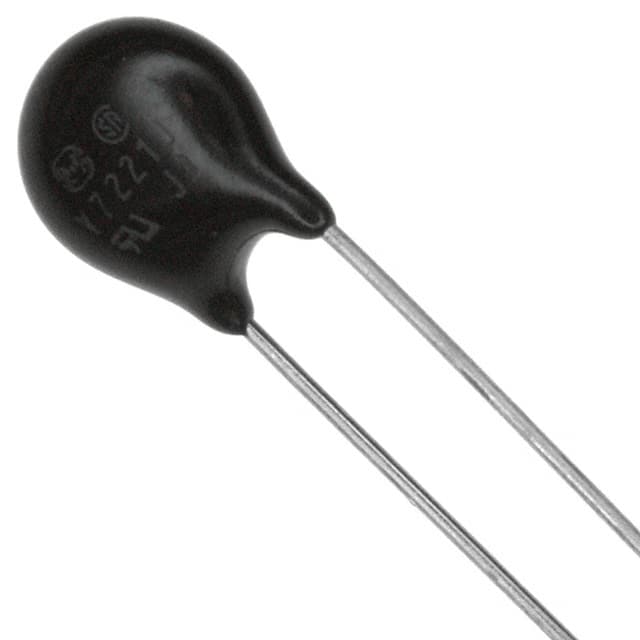Veja as especificações para detalhes do produto.

ERZ-V07D361 Product Overview
Introduction
The ERZ-V07D361 belongs to the category of electronic components and is commonly used for surge protection in various electrical and electronic systems. This entry provides a comprehensive overview of the ERZ-V07D361, including its basic information, specifications, pin configuration, functional features, advantages and disadvantages, working principles, application field plans, and alternative models.
Basic Information Overview
- Category: Surge Protection Device
- Use: Protecting electrical and electronic systems from voltage surges and transients
- Characteristics: High surge current capability, fast response time, low clamping voltage
- Package: DIP (Dual In-line Package)
- Essence: Zinc Oxide Varistor
- Packaging/Quantity: Typically available in reels or trays containing multiple units
Specifications
- Maximum Allowable Voltage: 360V
- Nominal Voltage: 275V
- Peak Current Capability: 6000A
- Response Time: <25ns
- Operating Temperature Range: -40°C to 85°C
Detailed Pin Configuration
The ERZ-V07D361 typically features a standard DIP package with two rows of parallel pins, with specific pin assignments for connection to the circuit board.
Functional Features
- Surge Protection: Provides effective protection against voltage surges and transients.
- Fast Response Time: Rapidly responds to transient events, minimizing the risk of damage to connected equipment.
- High Surge Current Capability: Capable of handling high surge currents, ensuring reliable protection.
Advantages and Disadvantages
Advantages
- Effective surge protection
- Fast response time
- High surge current capability
Disadvantages
- Limited to specific voltage ratings
- Requires proper installation and grounding for optimal performance
Working Principles
The ERZ-V07D361 utilizes a zinc oxide varistor (MOV) to suppress voltage surges by diverting excess current away from sensitive components. When a surge occurs, the varistor's resistance decreases, allowing it to conduct and dissipate the surge energy.
Detailed Application Field Plans
The ERZ-V07D361 is widely used in various applications, including: - Power distribution systems - Telecommunication equipment - Industrial automation - Consumer electronics - Renewable energy systems
Detailed and Complete Alternative Models
- ERZ-V05D471: Similar surge protection device with different voltage and current ratings
- ERZ-V10D271: Higher voltage rating variant for specific applications
- ERZ-V03D181: Lower voltage rating variant suitable for sensitive electronics
In conclusion, the ERZ-V07D361 surge protection device offers reliable protection against voltage surges and transients, making it an essential component in diverse electrical and electronic systems.
Word count: 443
Liste 10 perguntas e respostas comuns relacionadas à aplicação de ERZ-V07D361 em soluções técnicas
What is ERZ-V07D361?
- ERZ-V07D361 is a varistor, also known as a voltage-dependent resistor, that is commonly used to protect electronic circuits from overvoltage conditions.
What are the key specifications of ERZ-V07D361?
- The key specifications of ERZ-V07D361 include a maximum allowable voltage of 7V, a maximum peak current of 100A, and a nominal capacitance of 180pF.
How does ERZ-V07D361 function in technical solutions?
- ERZ-V07D361 functions by rapidly changing its resistance in response to changes in applied voltage, effectively diverting excess current away from sensitive components and protecting them from damage.
In what applications is ERZ-V07D361 commonly used?
- ERZ-V07D361 is commonly used in power supplies, telecommunication equipment, industrial control systems, and other electronic devices to provide overvoltage protection.
What are the advantages of using ERZ-V07D361 in technical solutions?
- The advantages of using ERZ-V07D361 include its ability to respond quickly to overvoltage events, its compact size, and its cost-effectiveness in providing surge protection.
How should ERZ-V07D361 be integrated into a circuit for optimal performance?
- ERZ-V07D361 should be connected in parallel with the circuit or component to be protected, ensuring that it can shunt excess current when an overvoltage event occurs.
What are the typical failure modes of ERZ-V07D361?
- The typical failure modes of ERZ-V07D361 include degradation of its protective capabilities over time due to repeated exposure to overvoltage events and excessive current.
Are there any temperature or environmental considerations when using ERZ-V07D361?
- ERZ-V07D361 operates within a specified temperature range and may have limitations in extreme environmental conditions, so it's important to consider these factors when designing with this varistor.
Can ERZ-V07D361 be replaced with other varistors in a circuit?
- While it's possible to replace ERZ-V07D361 with other varistors, it's important to ensure that the replacement varistor has similar or better electrical characteristics to maintain the desired level of protection.
What are the best practices for testing and verifying the functionality of ERZ-V07D361 in a technical solution?
- Best practices for testing ERZ-V07D361 include subjecting it to simulated overvoltage conditions and verifying that it effectively limits the voltage across the protected circuit or component. Additionally, periodic testing and inspection are recommended to ensure continued reliability.
Is there anything else you would like to know about ERZ-V07D361 or its application in technical solutions?

